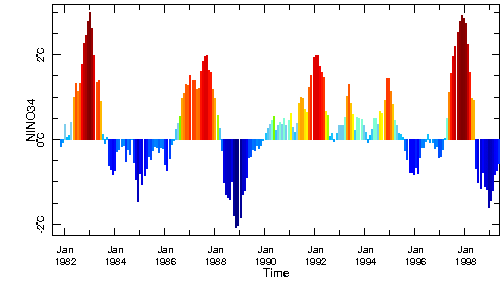
| ||||
IRI Climate Information Digest - January 1999
La Niña conditions continue: While the sea surface temperatures in the Eastern Pacific are only slightly colder than the average for this time of the year relatively strong and robust cold conditions characterize the Central and Western Equatorial Pacific. The time series of sea surface temperature anomalies (differences from the mean) given here are for an area 10 latitude degrees in extent centered on the equator from 120W to 170W. The graph shows that the magnitude of this cold episode (La Niña) has been larger than the lowest values of the 1984 episode and consistently colder than the recent 1996 episode. Further to the west the relatively cold waters are comparable in magnitude to the 1988 La Niña episode. Numerical models and statistical forecasts generally call for sustained cold conditions through February and March followed by a gradual decline of La Niña conditions over the following several month period. Global Precipitation patterns continue to show many of the characteristics commonly associated with La Niña conditions. For January 1999 this included generally wetter than average conditions in southern Africa from Zimbabwe and Mozambique through Botswana and Southern Africa, wetter condition were also experienced in parts of Australia, Indonesia northward to the southern Philippines, and wetter conditions in South America from Guyana through the western Amazon. Relatively drier than average conditions were noted in land areas adjacent to the Gulf of Mexico, the Central Equatorial Pacific islands and parts of eastern Africa from Kenya southward into Tanzania. Other areas with notable precipitation deficits not clearly associated with the La Niña include the southern island of New Zealand, southeastern Europe through the Middle East and the southern portions of Japan. Global temperature
patterns continue to show a preponderance of warmer than average conditions
over most of the world's land areas. Cooler than average temperatures over
tropical and sub-tropical land areas typically associated with La Niña
have only started to appear in equatorial South America. La Niña
related negative temperature departures have emerged in Alaska and western
Canada.
|

